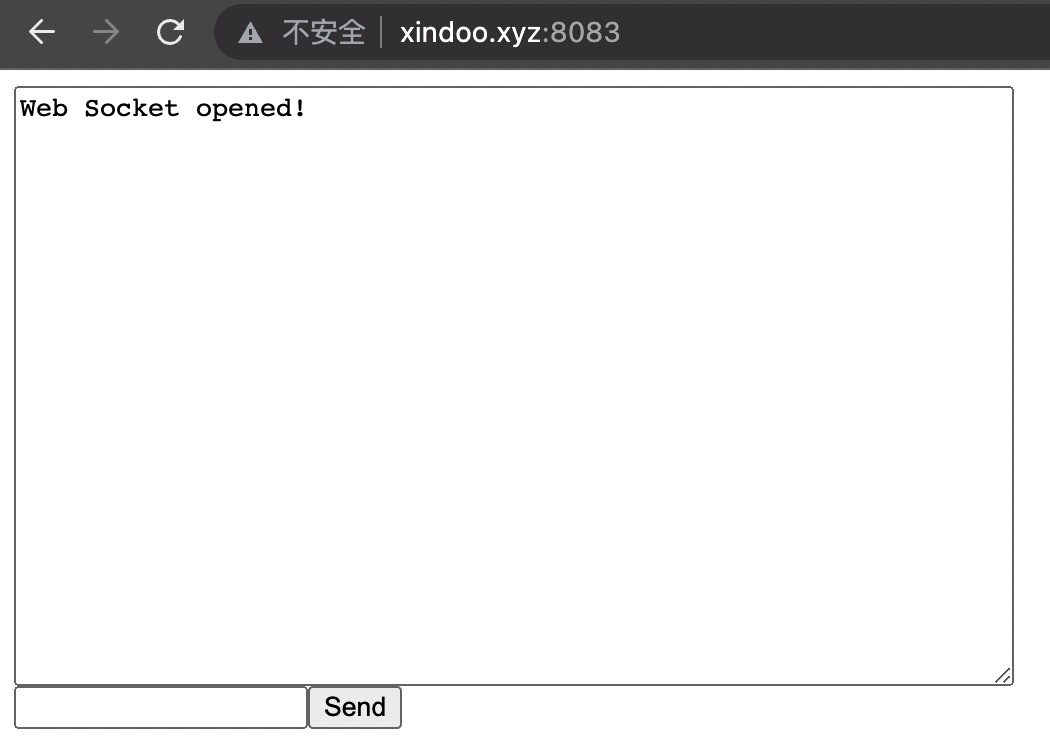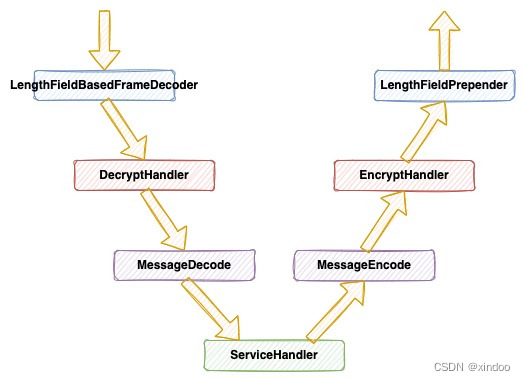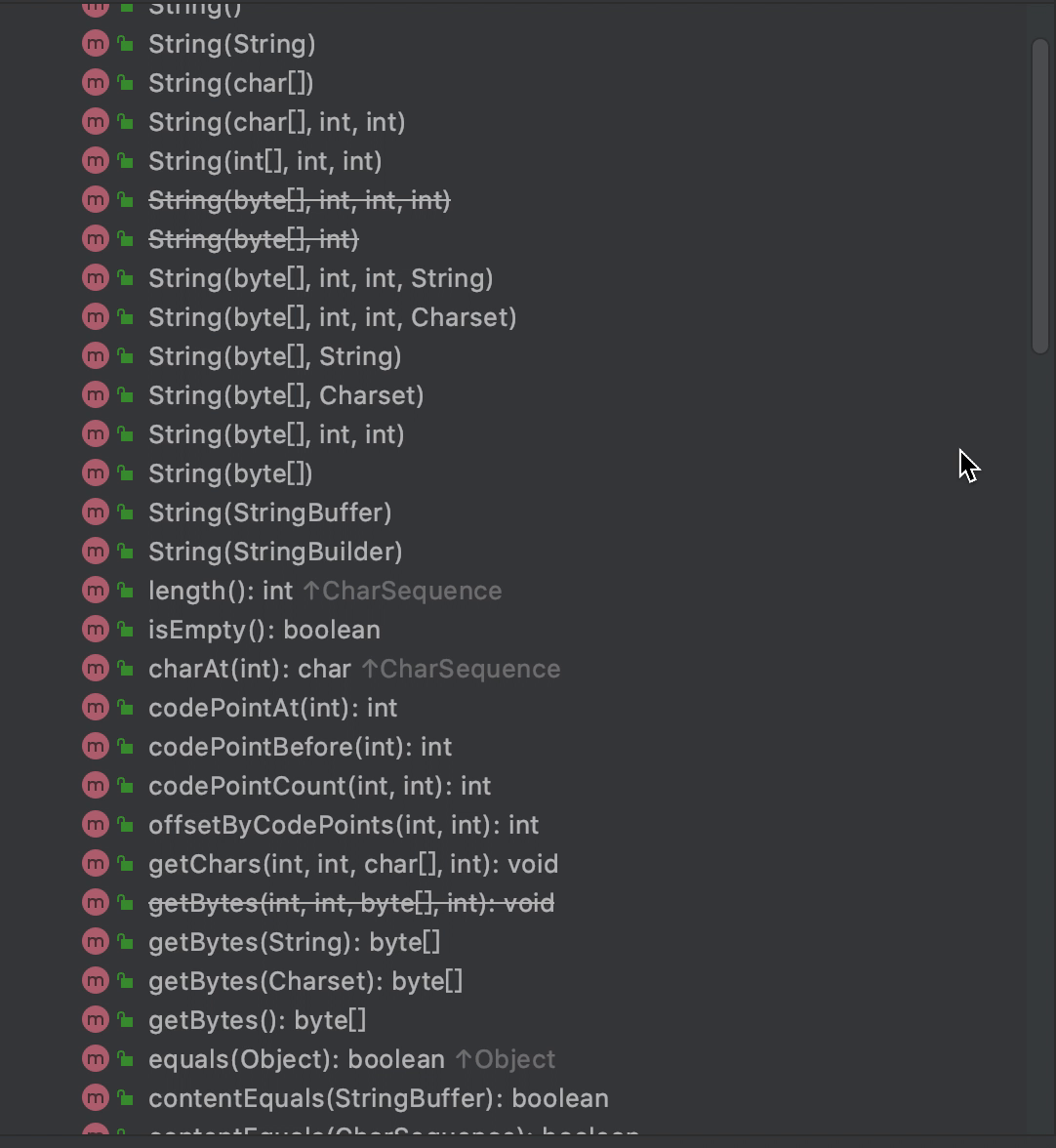
最近学习Netty,学习到WebSocket一章节,将Netty中WebSocket的样例代码做了一些简单的改造,实现了一个简易的WebSocket网络聊天室,源码并非完全自己实现,只是将一些别人的代码做了下整合改造,今分享至此,希望对大家学习Netty有所帮助。
首先介绍下什么是WebSocket,这就不得不先提到HTTP协议了。众所周知,在HTTP/2发布前,所有HTTP请求都是 请求-应答的 模式,这就意味着客户端只能向服务器要数据,然后服务端被动应答,而服务器无法主动将数据推送给客户端。这就导致一些高时效性的场景用HTTP就会有些问题,就拿实时聊天举例吧,客户端想知道近期有没有人说过话,就只能不断问服务器 有没有人发了消息? 有的话服务器就返回,没有就不返回,这种行为被称为轮询。 轮询的问题在于如果询问的时间间隔太长,消息的及时性无法得到保证,但如果时间太短,对服务器的压力就会大幅提升(因为不断要请求响应)。 有没有可能服务器有消息的时候,主动推送给客户端?
WebSocket因此而诞生,它允许客户端和服务端之间在HTTP之上建立一个全双工的TCP长连接,这里的关键点在于全双工,意味着服务端也能通过这个连接给客户端发送即时消息,从而解决了轮询的性能和时效性矛盾的问题。了解过Socket编程的同学应该很容易理解了,WebSocket其实本质上就是Socket,只不过WebSocket是建立在HTTP协议之上的。
回到我们的正题,如何用Netty+WebSocket写一个网络聊天室? 其实Netty里已经封装好了HTTP和WebSocket的实现,我们只需要实现部分聊天室的功能即可,接下来看下我实现的完整代码:
首先是ServerBootstrap的部分,这里是Netty的启动入口。
@Service
public class WebSocketServer {
static final String WEBSOCKET_PATH = "/ws";
private ChannelFuture f;
@Resource
private WebSocketFrameHandler webSocketFrameHandler;
@PostConstruct
private void init() {
bind(Constant.SOCKET_PORT);
}
public static voud bind(int port) {
EventLoopGroup bossGroup = new NioEventLoopGroup(1);
EventLoopGroup workerGroup = new NioEventLoopGroup();
try {
ServerBootstrap b = new ServerBootstrap();
b.group(bossGroup, workerGroup)
.channel(NioServerSocketChannel.class)
.handler(new LoggingHandler(LogLevel.INFO))
.childHandler(new ChannelInitializer<SocketChannel>() {
@Override
protected void initChannel(SocketChannel ch) throws Exception {
ChannelPipeline pipeline = ch.pipeline();
pipeline.addLast(new HttpServerCodec()); // netty中http协议的编解码
pipeline.addLast(new HttpObjectAggregator(65536));
pipeline.addLast(new WebSocketServerCompressionHandler());
pipeline.addLast(new WebSocketServerProtocolHandler(WEBSOCKET_PATH, null, true));
pipeline.addLast(new WebSocketIndexPageHandler(WEBSOCKET_PATH)); // demo页面的handler,这个是非必须的,可以换成其他第三方的WebSocket客户端工具
pipeline.addLast(webSocketFrameHandler); // 聊天室的主要逻辑
}
});
Channel f = b.bind(port).sync().channel();
f.closeFuture().sync();
} catch (Exception e) {
} finally {
bossGroup.shutdownGracefully();
workerGroup.shutdownGracefully();
}
}
} 因为HttpServerCodec HttpObjectAggregator WebSocketServerCompressionHandler WebSocketServerProtocolHandler是Netty组件中提供的组件,其作用就是完成Http和WebSocket协议数据到Java对象的相互转换,这里就不再展开了,我们直接看下剩下的两个Handler。
首先是WebSocketIndexPageHandler,这个也是我直接从Netty样例中Copy出来的,它的作用就是构建一个Http首页,这个首页实现了一个简单的WebSocket网页客户端,如果你不需要这个网页客户端,你也可直接删掉。
public class WebSocketIndexPageHandler extends SimpleChannelInboundHandler<FullHttpRequest> {
private final String websocketPath;
public WebSocketIndexPageHandler(String websocketPath) {
this.websocketPath = websocketPath;
}
private static void sendHttpResponse(ChannelHandlerContext ctx, FullHttpRequest req, FullHttpResponse res) {
// Generate an error page if response getStatus code is not OK (200).
HttpResponseStatus responseStatus = res.status();
if (responseStatus.code() != 200) {
ByteBufUtil.writeUtf8(res.content(), responseStatus.toString());
HttpUtil.setContentLength(res, res.content().readableBytes());
}
// Send the response and close the connection if necessary.
boolean keepAlive = HttpUtil.isKeepAlive(req) && responseStatus.code() == 200;
HttpUtil.setKeepAlive(res, keepAlive);
ChannelFuture future = ctx.writeAndFlush(res);
if (!keepAlive) {
future.addListener(ChannelFutureListener.CLOSE);
}
}
private static String getWebSocketLocation(ChannelPipeline cp, HttpRequest req, String path) {
String protocol = "ws";
if (cp.get(SslHandler.class) != null) {
// SSL in use so use Secure WebSockets
protocol = "wss";
}
return protocol + "://" + req.headers().get(HttpHeaderNames.HOST) + path;
}
@Override
protected void channelRead0(ChannelHandlerContext ctx, FullHttpRequest req) throws Exception {
// Handle a bad request.
if (!req.decoderResult().isSuccess()) {
sendHttpResponse(ctx, req, new DefaultFullHttpResponse(req.protocolVersion(), BAD_REQUEST,
ctx.alloc().buffer(0)));
return;
}
// Allow only GET methods.
if (!GET.equals(req.method())) {
sendHttpResponse(ctx, req, new DefaultFullHttpResponse(req.protocolVersion(), FORBIDDEN,
ctx.alloc().buffer(0)));
return;
}
// Send the index page
if ("/".equals(req.uri()) || "/index.html".equals(req.uri())) {
String webSocketLocation = getWebSocketLocation(ctx.pipeline(), req, websocketPath);
ByteBuf content = WebSocketServerIndexPage.getContent(webSocketLocation);
FullHttpResponse res = new DefaultFullHttpResponse(req.protocolVersion(), OK, content);
res.headers().set(CONTENT_TYPE, "text/html; charset=UTF-8");
HttpUtil.setContentLength(res, content.readableBytes());
sendHttpResponse(ctx, req, res);
} else {
sendHttpResponse(ctx, req, new DefaultFullHttpResponse(req.protocolVersion(), NOT_FOUND,
ctx.alloc().buffer(0)));
}
}
@Override
public void exceptionCaught(ChannelHandlerContext ctx, Throwable cause) {
cause.printStackTrace();
ctx.close();
}
}上面这部分代码还依赖于一个静态的页面,我对这个页面做了简单的改造,方便大家愉快地一起聊天。
public final class WebSocketServerIndexPage {
public static ByteBuf getContent(String webSocketLocation) {
return Unpooled.copiedBuffer("\n"
+ "<html><head><title>Web Socket Test</title></head>\n"
+ "<body>\n"
+ "<script type=\"text/javascript\">\n"
+ "var socket;\n"
+ "if (!window.WebSocket) {\n"
+ " window.WebSocket = window.MozWebSocket;\n"
+ "}\n"
+ "if (window.WebSocket) {\n"
+ " socket = new WebSocket(\"" + webSocketLocation + "\");\n"
+ " socket.onmessage = function(event) {\n"
+ " var ta = document.getElementById('responseText');\n"
+ " ta.value = ta.value + '\\n' + event.data\n"
+ " ta.scrollTop = ta.scrollHeight\n"
+ " };\n"
+ " socket.onopen = function(event) {\n"
+ " var ta = document.getElementById('responseText');\n"
+ " ta.value = \"Web Socket opened!\";\n"
+ " ta.scrollTop = ta.scrollHeight\n"
+ " };\n"
+ " socket.onclose = function(event) {\n"
+ " var ta = document.getElementById('responseText');\n"
+ " ta.value = ta.value + \"Web Socket closed!\";\n"
+ " ta.scrollTop = ta.scrollHeight\n"
+ " };\n"
+ "} else {\n"
+ " alert(\"Your browser does not support Web Socket.\");\n"
+ "}\n"
+ "\n"
+ "function send(message) {\n"
+ " if (!window.WebSocket) { return; }\n"
+ " if (socket.readyState == WebSocket.OPEN) {\n"
+ " socket.send(message);\n"
+ " document.getElementById('msgForm').value = ''\n"
+ " } else {\n"
+ " alert(\"The socket is not open.\");\n"
+ " }\n"
+ "}\n"
+ "</script>\n"
+ "<textarea id=\"responseText\" style=\"width:500px;height:300px;\"></textarea>\n"
+ "<form onsubmit=\"return false;\">\n"
+ "<input type=\"text\" name=\"message\" id=\"msgForm\"/><input type=\"button\" value=\"Send\"\n"
+ " onclick=\"send(this.form.message.value)\" />\n"
+ "</form>\n"
+ "</body>\n"
+ "</html>\n", CharsetUtil.US_ASCII);
}
} 改造后的页面效果长这样,虽然有些简陋,但还是可以收发消息。

最核心的就是WebSocketFrameHandler这个类了,所有的逻辑都是在这里面的,其实也不复杂,就是在连接建立后,给这个连接分配一个随机名字,将某个人发的消息转发到其他已有的连接上,另外及时清理掉断开的连接,防止资源泄露,代码很简单,相信你一看就懂。
@Service
@Slf4j
@ChannelHandler.Sharable
public class WebSocketFrameHandler extends SimpleChannelInboundHandler<WebSocketFrame> {
// 我直接取了天龙八部里的名字,给每个聊天的人随机分配一个
private final List<String> names =
List.of("刀白凤", "丁春秋", "马夫人", "马五德", "小翠", "于光豪", "巴天石", "不平道人", "邓百川", "风波恶",
"甘宝宝", "公冶乾", "木婉清", "少林老僧", "太皇太后", "天狼子", "天山童姥", "王语嫣", "乌老大",
"无崖子", "云岛主", "云中鹤", "止清", "白世镜", "包不同", "本参", "本观", "本相", "本因", "出尘子",
"冯阿三", "兰剑", "古笃诚", "过彦之", "平婆婆", "石清露", "石嫂", "司空玄", "司马林", "玄慈",
"玄寂", "玄苦", "玄难", "玄生", "玄痛", "叶二娘", "竹剑", "左子穆", "华赫艮", "乔峰", "李春来",
"李傀儡", "李秋水", "刘竹庄", "朴者和尚", "祁六三", "全冠清", "阮星竹", "西夏宫女", "许卓诚",
"朱丹臣", "努儿海", "阿碧", "阿洪", "阿胜", "阿朱", "阿紫", "波罗星", "陈孤雁", "鸠摩智", "来福儿",
"孟师叔", "宋长老", "苏星河", "苏辙", "完颜阿古打", "耶律洪基", "耶律莫哥", "耶律涅鲁古",
"耶律重元", "吴长风", "吴光胜", "吴领军", "辛双清", "严妈妈", "余婆婆", "岳老三", "张全祥",
"单伯山", "单季山", "单叔山", "单小山", "单正", "段延庆", "段誉", "段正淳", "段正明", "范禹",
"范百龄", "范骅", "苟读", "和里布", "何望海", "易大彪", "郁光标", "卓不凡", "宗赞王子", "哈大霸",
"姜师叔", "枯荣长老", "梦姑", "姚伯当", "神山上人", "神音", "狮鼻子", "室里", "项长老", "幽草",
"赵钱孙", "赵洵", "哲罗星", "钟灵", "钟万仇", "高升泰", "龚光杰", "贾老者", "康广陵", "秦红棉",
"虚竹", "容子矩", "桑土公", "唐光雄", "奚长老", "徐长老", "诸保昆", "崔百泉", "崔绿华", "符敏仪",
"黄眉和尚", "菊剑", "聋哑婆婆", "梅剑", "萧远山", "游骥", "游驹", "游坦之", "程青霜", "傅思归",
"葛光佩", "缘根", "智光大师", "鲍千灵", "褚万里", "瑞婆婆", "端木元", "黎夫人", "薛慕华", "慕容博",
"慕容复", "谭公", "谭婆", "谭青", "摘星子", "慧方", "慧观", "慧净", "慧真", "穆贵妃", "赫连铁树");
// 名字到连接的映射
private final Map<String, ChannelHandlerContext> name2ctx = new ConcurrentHashMap<>();
// 连接到名字的映射
private final Map<ChannelHandlerContext, String> ctx2name = new ConcurrentHashMap<>();
@Override
public void channelRegistered(ChannelHandlerContext ctx) throws Exception {
// 先分配当前没有在使用中的名字
Optional<String> nameOp = names.stream().filter(x -> !name2ctx.containsKey(x)).findFirst();
if (!nameOp.isPresent()) {
// 如果没分配到名字,直接断开连接,这么写的话,同时在线的人数取决于名字列表的大小
ctx.writeAndFlush(new TextWebSocketFrame("当前连接人数过多,请稍后重试!"));
log.info("当前连接人数过多,请稍后重试!");
ctx.close();
return;
}
String name = nameOp.get();
name2ctx.put(name, ctx);
ctx2name.put(ctx, name);
broadcast(name + "加入了群聊!");
}
@Override
public void channelUnregistered(ChannelHandlerContext ctx) throws Exception {
String name = ctx2name.getOrDefault(ctx, "");
name2ctx.remove(name);
ctx2name.remove(ctx);
broadcast(name + "离开了群聊!");
}
@Override
protected void channelRead0(ChannelHandlerContext ctx, WebSocketFrame frame) throws Exception {
// 收到消息后将消息群发给所有人
if (frame instanceof TextWebSocketFrame) {
String request = ((TextWebSocketFrame) frame).text();
String name = ctx2name.getOrDefault(ctx, "");
broadcast(name + ":" + request);
} else {
String message = "unsupported frame type: " + frame.getClass().getName();
throw new UnsupportedOperationException(message);
}
}
/**
* 将消息群发给所有在线的人
*/
private void broadcast(String msg) {
log.info("msg:{}", msg);
name2ctx.entrySet().parallelStream().forEach(e -> {
String name = e.getKey();
ChannelHandlerContext ctx = e.getValue();
if (ctx.channel().isActive()) {
ctx.writeAndFlush(new TextWebSocketFrame(msg));
} else {
// 广播时清理掉不活跃的连接
ctx2name.remove(ctx);
name2ctx.remove(name);
}
});
}
} 这里特别提醒下,想实现群聊,那WebSocketFrameHandler必须标记为Sharable,并且全局共享一个对象,所以需要注意下线程安全的问题,这里我都用了ConcurrentHashMap。
以上就是完整的代码了,有兴趣可以自己跑一跑,另外这个网络聊天室我已经部署的我的服务器上了,也可以直接点开体验下 http://xindoo.xyz:8083/。







